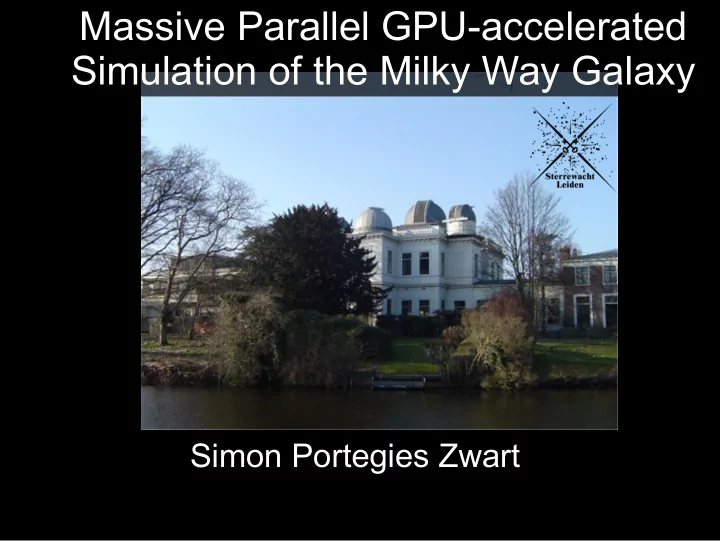

Massive Parallel GPU-accelerated Simulation of the Milky Way Galaxy Simon Portegies Zwart
1608 Lippershey For the last 400 years telescopes became larger
CAStLe group
Computational Astrophysics and Cosmology Open Access Springer Journal CompAC publishes paper on ● Astronomy, physics and cosmology ● Computational and information science The combination of these two disciplines leads to a wide range of topics which, from an astronomical point of view covers all scales and a rich palette of statistics, physics and chemistry. Computing is interpreted in the broadest sense and may include hardware, algorithms, software, networking, data management, visualization, modeling, simulation, visualization, high-performance computing and data intensive computing.
The Pillars of Science
~4.5Gyr old 13,000km 360,000km away
~100 billion stars ~13Gyr old ~ 1 trillion planets > 1 quadrillion planetesimals 10 19 km
we ignore: The rest of the universe (our galaxy is isolated) The interstellar gas (~15% of the Galactic mass) Magnetic fields The evolution of the stars The prescence of planets and planetesimals The Human population (and any other form of life) We ignore everything, except...
1642-1727
Gravity's complexities ● Gravity has a negative heat capacity. As a consequence, our daily experience is not trained to appreciate the complexities of gravity. ● The force calculation is an N*N operation. ● There is no shielding in gravity, such as in molecular dynamics: the system is global-aware. ● At small distances the main driving force (gravity) grows limitless. ● The equations of motion are intrinsically chaotic.
N stars ~ 100,000,000,000 N interactions ~ 10,000,000,000,000,000,000,000 N steps ~ 100,000 N flops ~ 10,000,000,000,000,000,000,000,000,000 yotta zetta
1908-2000 10mFlops
Erik Holmberg 1908-2000
von Neuman & IAS 1960 2003 ~30 000 000 times faster Jun & GRAPE-4 500BC
Bedorf & PZ, 2012
This talk Bedorf & PZ, 2012
Bonsai Small, but strong in the force Available as part of the AMUSE framework at amusecode.org Bedorf et al 2014
Leiden LGM 400GPUs=0.5PFflops Tsukuba 4GPUs = 0.005PFlops 40 GPUs=0.05PFlops CSCS Piz Daint 4000GPUs=5PFflops ~20000GPUs= 25PFflops ORNL Titan
Bonsai gravitationalTreecode
Novelties ● All force calculations on the GPU ● 2D space filling curve for the domain decomposition (allows higher degree of parallelism) ● Flactal-shaped domains combined with Tree structure (Allows asynchronicity: no communication during tree traversal) ● Use the fractal domain edges to minimize communication (Allows bulk data transport with exactly the right amount of data: saves latency and bandtwidth)
Peano-Hilbert Space Filling Curve
Titan Node usage
Titan Node Usage
HPC on Titan's GPU-farm
Jeroen Bédorf etal: simulation of Andromeda/Milky Way encounter on Titan
Being able to perform large calculations is not the same as being able to perform accurate calculations ● “ Errors in calculations of n-body systems grow exponentially … and may therefore invalidate the results ... ” (Miller 1964)
BRUTUS a brute force arbitrary-precision N-body code ● Two ingredients: ● Gragg-Bulirsch-Stoer method – Modified midpoint method – Richardson extrapolation – Tolerance parameter ● Arbitrary-Precision arithmetic – Number of significant digits Tjarda Boekholt 30
Red: dE/E <10 -74 Black: dE/E <10 -11
10,000 realizations of N=3 give no systematic bias 32
Next step 33
Conclusions ● 24.773 PetaFlop/s on Titan (18600 nodes): about 90% efficiency ● Simulate 1Gyr of the Milky Way in about 1 day. ● All calculations on the GPUs ● Load-balance/communication/a- sync I/O on the CPU 34
Recommend
More recommend